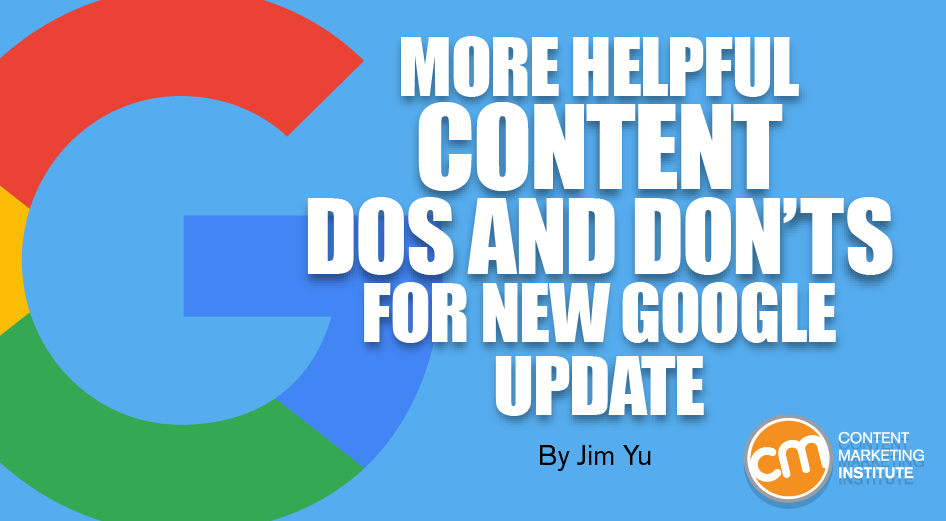Though Google’s algorithm constantly evolves, one thing has remained relatively constant – the importance of quality content.
In 2013, Google implemented your money or your life principles, recognizing pages with content related to a person’s well-being with a higher page quality. In 2014, it shared the guidelines around EAT – expertise, authoritativeness, and trustworthiness, rewarding content that possessed those three qualities.
That’s why its new helpful content update isn’t surprising, though it has caused a stir among content and SEO marketers.
Given the update’s sitewide impact, any domain with a high amount of low-quality content is at risk of seeing a decline in its search rankings. The update uses machine learning to determine whether a site’s content is helpful, and sites found lacking in this regard will be penalized accordingly.
This update is yet another reminder that quality should always be a top priority for anyone looking to improve their search rankings.
5 dos to create helpful content
To produce helpful content, you need to become more thoughtful about understanding your target audience, their search intent, who you target, and what you create.
First, think about how audiences become frustrated with sites and, specifically, content. They don’t like:
- Visiting web pages that do not satisfy their wants and needs
- Pages with content lacking insights or value
- Content that looks like a machine created it
- Content that does not give answers nor shows empathy and/or added value
- Content primarily targeted to search engine ranking with no relevance
Take a step back and really think about the experience of your target audience. Once you have a good understanding, you can update or create content better aligned with their interests.
It is also essential to ensure your authors know the subject matter. If they are not an expert on the topic, be sure they do the research to provide accurate information.
Follow these five steps to ensure your content attracts searchers (and higher rankings):
- Conduct an audit. Look for areas on your site, such as pages, articles, and posts that have stale and unhelpful content.
- Monitor keywords and rankings. See what content is working and what content isn’t in real time and over a longer time span.
- Leverage data and insights. Understand where opportunities are and align with reader intent.
- Target audiences relevant to your business with content that’s relevant to their needs.
- Write better content, keeping in mind humanity along with the need to display expertise, authoritativeness, and trustworthiness.
HANDPICKED RELATED CONTENT:
7 don’ts to ensure Google sees your content as helpful
Must-do guidelines often are followed by don’t guidelines. According to the new guidelines, you should avoid:
- AI-generated technologies that automate creating content around keywords
- Targeting trending keywords outside your site’s core competencies
- Repeating content from other websites or manufacturers’ descriptions
- Overoptimize keywords on pages
- Clickbait titles that do not align with what the page offers
- Pages that would require the user to go back and do another search to get more detail
- Summarizing what other content says without adding value
By following these dos and don’ts, you can create engaging, informative, and tailored content for your target audience. And that’s a big help in the eyes of Google.
HANDPICKED RELATED CONTENT:
Potential impact of helpful content update across industries
Some industries may experience more effects of this update than others. According to Google, the sectors most affected by this update include online-educational materials, entertainment, shopping, and tech-related content.
The role of data-led insights is a key driver of content performance and outcomes in an era of helpful content. For example, if you look at shopping (e-commerce), SEO data reveals patterns and informs content marketers on where to focus quality and helpful content. As illustrated in this chart, article and category pages have the highest click-through rates based on the number of keywords, indicating they are critical content pages.

Image source: BrightEdge Research Aug 2022
The new helpful ranking signal will grow stronger as it is exposed to more data from searches.
Strike a helpful balance
It’s how SEO and content work together in the future that matters the most. You should balance content that satisfies the needs of the user and is discoverable. Focus your efforts toward data-driven, intent-based modeling – writing from people for people – and be thoughtful about how you optimize.
In the past, organizations could get away with cranking out large volumes of low-quality content to game the search ranking system and attract attention.
Today’s algorithms are more sophisticated. It is vital that organizations invest in high-quality, human-generated content. Marketers that take the time to be thoughtful, such as using qualitative research and showing empathy, about their users or customers are more likely to succeed in the long run.
Only time will tell how exactly this update will change things. It needs a few months to roll out and gather speed so we can see the broader effects and get a better picture going forward. Stay tuned.
Cover image by Joseph Kalinowski/Content Marketing Institute

